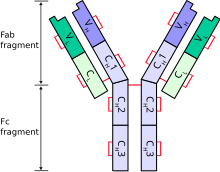Idiotype
This article includes alist of references,related reading,orexternal links,but its sources remain unclear because it lacksinline citations.(January 2014) |

Inimmunology,anidiotypeis a shared characteristic between a group ofimmunoglobulinorT-cell receptor(TCR) molecules based upon theantigenbinding specificity and therefore structure of theirvariable region.The variable region of antigen receptors ofT cells(TCRs) andB cells(immunoglobulins) containcomplementarity-determining regions(CDRs) with uniqueamino acidsequences. They define the surface and properties of the variable region, determining the antigen specificity and therefore the idiotopeof the molecule. Immunoglobulins or TCRs with a sharedidiotopeare the same idiotype.Antibody idiotype is determined by:
- Gene rearrangement
- Junctional diversity
- P-nucleotides (palindromic nucleotides at sites of single-strand breaks)
- N-nucleotides
- Somatic hypermutations
Etymology and usage
[edit]The word idiotype comes from two Greek roots,idiomeaning 'private, distinctive, peculiar' andtyposmeaning 'mark.' Thus, idiotype describes the distinctive sequence and region that makes any immunoglobulin/TCR unique from others of the same type which is its variable region.
The term "idiotype" is sometimes used to describe the collection of multiple idiotopes, and therefore overall antigen binding capacity, possessed by an antibody.
The word "idiotype" became influential in immunology whenNiels Jerneformulated hisimmune network theory.Jerne was awarded theNobel Prize in Physiology or Medicinein 1984 largely for being the father of immune network theory. He defined idiotype as the set of epitopes on the V region of an antibody molecule, whereepitopemeans an antigenic determinant. He also defined the "paratope"to be that part of an antibody variable region that binds to an antigen. The best developed version of immune network theory is called thesymmetrical network theory,in which the distinction between idiotype and paratope plays no role.
See also
[edit]External links
[edit]- Immunoglobulin+idiotypesat the U.S. National Library of MedicineMedical Subject Headings(MeSH)
- OverviewatMedical University of South Carolina
- OverviewatSouthern Illinois University Carbondale
